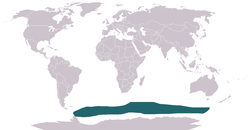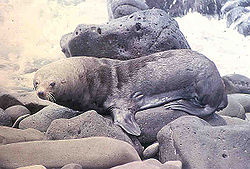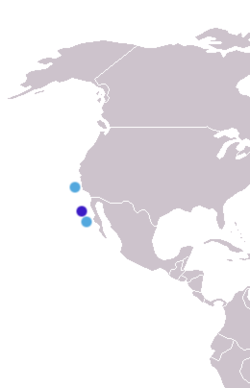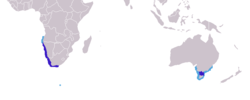| Common name | Scientific name and subspecies | Range | Size and ecology | IUCN status and estimated population |
|---|
| Antarctic fur seal  | Arctocephalus gazella
(Peters, 1875) | Subantarctic islands
 | Size: Male: 180 cm (71 in) long; 130–200 kg (287–441 lb)
Female: 120–140 cm (47–55 in) long; 22–50 kg (49–110 lb) [6]
Habitat: Neritic marine, oceanic marine, intertidal marine, and coastal marine [6]
Diet: Krill, cephalopods, fish, and penguins [6] | LC
700,000–1,000,000 
|
|---|
| Guadalupe fur seal  | Arctocephalus townsendi
(Merriam, 1897) |
 | Size:
Habitat:
Diet: | LC
|
|---|
| Juan Fernández fur seal  | Arctocephalus philippii
(Peters, 1866) |
 | Size:
Habitat:
Diet: | LC
|
|---|
| Galápagos fur seal  | Arctocephalus galapagoensis
(Heller, 1904) | Galápagos Islands
 | Size: Male: 150–160 cm (59–63 in) long; 60–68 kg (132–150 lb)
Female: 110–130 cm (43–51 in) long; 27–33 kg (60–73 lb) [7]
Habitat: Neritic marine, oceanic marine, intertidal marine, and coastal marine
Diet: Small squids and a variety of fish | EN
10,000 
|
|---|
| Brown fur seal or Cape fur seal  | Arctocephalus pusillus
(Schreber, 1775)
- A. p. pusillus(Cape/South African fur seal)
- A. p. doriferus(Australian fur seal)
| Southern African and Australian coasts (dark blue indicates breeding grounds)
 | Size: Male: 201–227 cm (79–89 in) long; 218–360 kg (481–794 lb)
Female: 136–171 cm (54–67 in) long; 41–113 kg (90–249 lb) [8]
Habitat: Neritic marine, oceanic marine, intertidal marine, and coastal marine
Diet: A wide variety of fish, cephalopods, and crustaceans, and sometimes African penguins and other seabirds | LC
1,060,000 
|
|---|
| New Zealand fur seal  | Arctocephalus forsteri
(Lesson, 1828) |
 | Size:
Habitat:
Diet: | LC
|
|---|
| Subantarctic fur seal  | Arctocephalus tropicalis
(Gray, 1872) |
 | Size:
Habitat:
Diet: | LC
|
|---|
| South American fur seal  | Arctocephalus australis
(Zimmermann, 1783) |
 | Size:
Habitat:
Diet: | LC
|
|---|





















